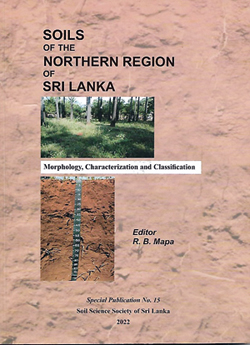In-depth look at soils of the North
“Soils of the Northern Region of Sri Lanka: Morphology, Characterization and Classification” was released on World Soil Day – December 5 by the Soil Science Society of Sri Lanka, filling an important void on knowledge related soils and environment of the Northern region. Edited by Prof. Ranjith Mapa, the book provides information on soils found in the Northern region and related environmental factors. Consisting of 242 pages with 31 colour plates, 24 illustrations and a map showing distribution of soils at series level, it compiles the most recent information on soils and related subjects with contributions from eminent scientists.

Soils of the Northern Region of Sri Lanka Edited by Ranjith B. Mapa Reviewed by Prof. C.B. Dissanayake
The introductory chapter by Professors R.B. Mapa and Udaya Vithrana with the history of soil survey and classification work in the North, describes how the relevant information was collected from 12 benchmark study sites, their compilation and mapping procedure. Climate and Geology, which are major soil forming factors, are discussed in Chapters 2 and 3 respectively. The chapter on Climate of the Northern region is authored by Dr. B.V.R. Punyawadena and A.B. Abesekara of the Natural Resource Management Center, Dept of Agriculture, Peradeniya, providing information on all climatic factors from long term averages of rainfall to evapo-transpiration for many locations. Chapter 3 on “Geology & Geo-Morphology” by Prof. Rohana Chandrajith and Dr. Saranga Diyabalanage gives a detailed geological map of the Jaffna Peninsula in addition to major geologic and geomorphology maps for the Northern region.
“Land Use” by Prof. Nalina Gnanavelrajah of the University of Jaffna gives an account of district wise present land use including a land use map for this region. The main land use issues and the need for district level land use planning for sustainable use of land resources in the Northern region is highlighted in this chapter.
Chapter 5 which is on ‘Morphology, Characterizations and Classification of Northern Region” authored by Prof. Ranjith Mapa and Anil Dassanayake provides information on 12 benchmark sites. These soils are discussed according to how they occur in landscape positions. Detailed information is provided for each soil series with the names used in the 1972 classification by de Alwis & Panabokke and according to most recent international classification methods. Colour plates of the landscape and soil profiles are provided for easy identification. A soil map showing the distribution of these soil series in the Northern region is attached to the back cover. Field and laboratory work described in the chapter was funded by a grant from the National Research Council of Sri Lanka (NRC).
In Chapter 6, the” Mineralogy of Soils of the Northern Region” is discussed by Prof. Srimathi Indraratne providing recent information on soil mineralogy, lacking all these years. This information, especially on clay mineralogy, is useful in predicting the nutrient retention capacity and behaviour of soils of this region. The only soil series containing high amount of monmorillinitic clay among Sri Lankan soils, the Murunkkan soil series, is discussed in detail.
The crucial soil physical and chemical prosperities for the surface and sub-surface depths for all 12 soil series are tabulated and the risks and limitations imposed by them for agricultural and environmental issues are discussed by Prof. Darshi Kumaragamage in Chapter 7.
Prof. S.P. Nissanka and
N. Geekiyanage authored the chapter on “Natural Eco-systems in North and East Region” adding information on vegetation types found in this region. It also highlights the conservation needs for these ecosystems useful for policy makers.
The final chapter is on “Management of Northern Region Soils for Agriculture”, where Prof. Punitha Premanandarajah of the Eastern University discusses management of these soils for rice cultivation, especially taking into account the soil salinity issue.Management of these soils for other field crops (OFC’s) is discussed by Ms. P. Gowthamy of the Provincial Department of Agriculture of the Northern Province, where suitability of each soil series for growing OFC’s and their management options are discussed. The management of the Northern soils for coconut cultivation is by Mr. A.H. Kulasiri of CIC Agri-business. How these soils could be placed in Land Suitability Classes for coconut and management options including fertilizer application and irrigation are discussed in detail.
The Appendix of the book provides the soil landscape and profile descriptions, measured soil physical and chemical properties for each identified horizon for all 12 benchmark sites. This will provide researchers data for simulation models and to follow how the soils were classified using these data.
All the data measured in previous studies by the same authors for Wet, Intermediate, Dry Zones of Sri Lanka with data for the Northern region totalling to 114 benchmark sites for four horizons for 15 physical and chemical properties could be downloaded as a Mendeley data from the link https://data.mendeley.com/datasets/5sc7njfcyn/1 DOI: 10.17632/5sc7njfcyn.1. This book fills a void in the knowledge on soils and environmental factors which are useful for soil scientists, geologists, foresters, land use planners and policy makers of the Northern Region
(The reviewer is Emeritus Professor at the University of Peradeniya)
Searching for an ideal partner? Find your soul mate on Hitad.lk, Sri Lanka's favourite marriage proposals page. With Hitad.lk matrimonial advertisements you have access to thousands of ads from potential suitors who are looking for someone just like you.


